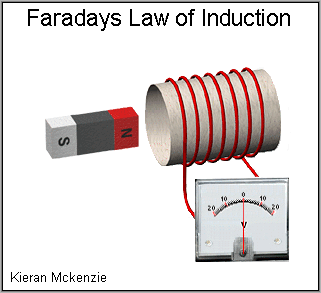|
The source of the changing magnetic fields in MRI may either be the imaging gradients or radiofrequency (RF) coils. The conductive material in which eddy currents are induced may be any metallic component of the MR scanner (other coils, shields, tubes, and housing), wires or devices within or on the patient, and the patient as a whole (in the final analysis, people are just big bags of saline!)
|
The Faraday-Lenz Law of electromagnetism states that electrical currents are induced in nearby conductors by a changing magnetic field. Since MR uses rapidly changing magnetic fields to generate and spatially define the signal, swirling ('eddy') currents are always produced whenever imaging is performed. Eddy currents within the patient may produce important biological effects such as tissue heating or peripheral nerve stimulation. These concepts deserve several Q&A's of their own and are considered in detail in the Quality and Safety section of this website. The present discussion deals with eddy currents induced in the MR scanner itself. |

Eddy currents degrade the speed and efficiency of gradient switching; electrical pulses driving the gradients become distorted, producing a wide range of image artifacts, including shearing, shading, scaling, blurring, and spatial misregistration. Eddy currents within the cryostat produce Joule heating, degrading the quality of the magnetic field and resulting an increased boil-off of cryogens.
1) Design methods that interrupt potential current loops (use of slotted coils and shields)
2) Active shielding of gradients (secondary coils outside to constrain magnetic flux changes induced by primary gradients);
3) Pre-emphasis (modifying the input current to the gradients to account for expected eddy-current distortions); and
4) Image post-processing (to correct for spatial nonlinearities and frequency/phase shifts due to eddy currents)
These methods will be described in more detail in subsequent questions.
Advanced Discussion (show/hide)»
A few additional notes concerning adverse effects of eddy currents. . . .
Multiple eddy currents with different time constants always coexist. The most rapid eddy currents (with time constants on the order of a few hundred micro(μ)-seconds) are present in the RF coil and shield. These are responsible for the Nyquist N/2 artifact described above. Intermediate term eddy currents (on the order 1-100 milliseconds) typically originate in the walls of the cryostat or outer radiation shields and produce shading artifacts on fast (turbo) spin echo or gradient echo images. Eddy currents with long time constants (hundreds of milliseconds) often derive from the inner cryogen shields and produce frequency drifts in the main field. This may be manifest on images as insufficient fat or water suppression.
Eddy currents are particularly problematic in localized spectroscopy, where they cause broadened resonances and distorted line shapes, especially in short TE experiments. At times they may completely prevent the acquisition of localized MRS measurements.
In diffusion-weighted imaging, eddy currents can result in spuriously high ADC values.
In all forms of echo-planar imaging, eddy current gradients and field shifts produce distinctive geometric image distortions. These include: 1) image shearing artifacts (from induced gradients in the frequency-encode direction); 2) image scaling artifacts (from induced gradients in the phase-encode direction), and 3) global position shifts (from homogenous shifts in the Bo field).
Ahn CB, Cho ZH. Analysis of the eddy-current Induced artifacts and the temporal compensation in nuclear magnetic resonance imaging. IEEE Trans Med Imaging 1991; 10:47-52.
Doty FD. MRI gradient coil optimization. In: Blumler P, Blumich B, Botto R, Fukushima E (eds), Spatially Resolved Magnetic Resonance. Wiley; 1998, pp 647-674.
Schmitt F. The gradient system. Understanding gradients from an EM perspective. Proc Intl Soc Mag Reson Med 2013; 21:1-13.
Spees WM, Buhl N, Sun P et al. Quantification and compensation of eddy-current-induced magnetic-field gradients. J Magn Reson 2011; 212:116-23.
Trakic A, Liu F, Sanchez Lopez H et al. Longitudinal gradient coil optimization in the presence of transient eddy currents. Magn Reson Med 2007; 57:1119-1130.
Why do the scanner walls get so warm?
What is pre-emphasis and how does it reduce eddy currents?
What are actively shielded gradients?



